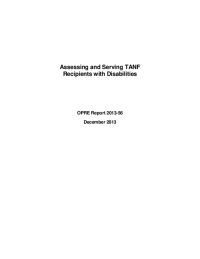Assessing and Serving TANF Recipients with Disabilities
Policymakers and program operators have long worked to understand how state and federal programs can best serve low-income families headed by a parent (or parents) with a disability. The Temporary Assistance for Needy Families (TANF) program, administered by the Administration for Children and Families (ACF), serves low-income families, some of which include individuals who have work limitations or disabilities. The Supplemental Security Income (SSI) program, administered by the Social Security Administration (SSA), serves low-income individuals who are aged, blind, or disabled. While ACF and SSA have common goals of supporting vulnerable populations while encouraging their self-sufficiency and employment, the two agencies’ differing missions, programmatic and financial challenges, definitions of disability, and rules and incentives related to work pose challenges to coordinating their efforts.
In order to understand how best to help TANF recipients with disabilities, ACF and SSA contracted with MDRC and its partners, MEF Associates and TransCen, to conduct the TANF/SSI Disability Transition Project (TSDTP). The goals of the TSDTP are to explore the connection between the two programs, build knowledge about ways to encourage work among TANF recipients with disabilities, facilitate informed decisions about applying for SSI when appropriate, and help eligible SSI applicants receive awards as quickly as possible while also reducing administrative costs. Through MDRC’s close collaboration with ACF, SSA, and participating state and county TANF agencies, the TSDTP conducted field assessments of existing services for TANF recipients who may have disabilities, tested pilot programs targeted to this population, and analyzed national- and state-level program data.
TANF recipients with disabilities represent a sizable portion of the adult TANF population, but identifying the needs of clients with disabilities and offering them appropriate services can prove difficult for TANF programs and their staffs. Previous research estimates that around one in four adult TANF recipients has a disability, commonly defined as a physical, mental, or emotional issue that keeps a person from working or limits the kind or amount of work that person can do. TANF programs employ many different types of assessments to identify disabilities among recipients, including disability screenings, psychosocial and psychological assessments, clinical assessments, functional needs assessments, and vocational assessments. This practice brief describes different assessment strategies used by local agencies and organizations participating in the TANF/SSI Disability Transition Project, discusses strengths and weaknesses of various approaches to assessment, and offers some points for program administrators and practitioners to consider in choosing methods of assessment.






